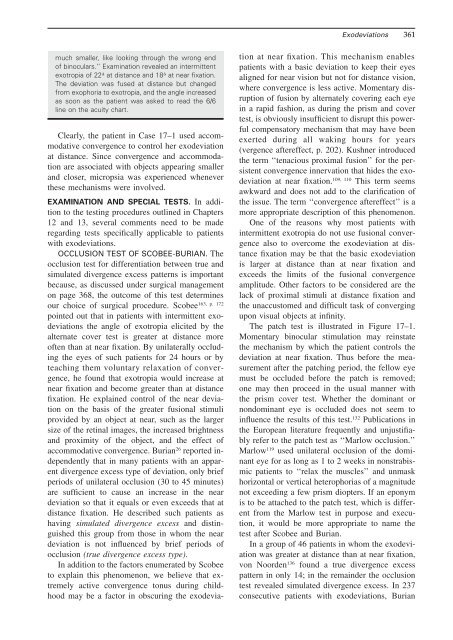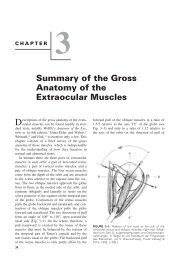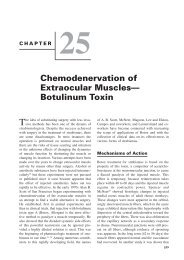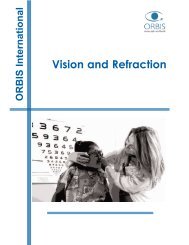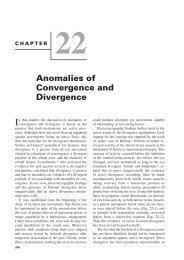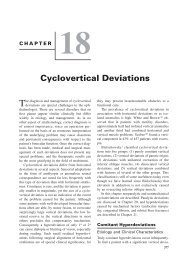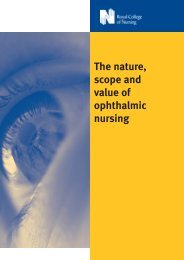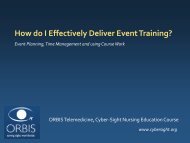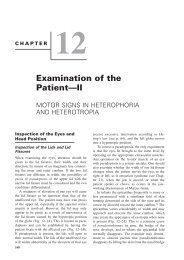Chapter 17: Exodeviations
Chapter 17: Exodeviations
Chapter 17: Exodeviations
Create successful ePaper yourself
Turn your PDF publications into a flip-book with our unique Google optimized e-Paper software.
<strong>Exodeviations</strong> 361much smaller, like looking through the wrong endof binoculars.’’ Examination revealed an intermittentexotropia of 22 at distance and 18 at near fixation.The deviation was fused at distance but changedfrom exophoria to exotropia, and the angle increasedas soon as the patient was asked to read the 6/6line on the acuity chart.Clearly, the patient in Case <strong>17</strong>–1 used accommodativeconvergence to control her exodeviationat distance. Since convergence and accommodationare associated with objects appearing smallerand closer, micropsia was experienced wheneverthese mechanisms were involved.EXAMINATION AND SPECIAL TESTS. In additionto the testing procedures outlined in <strong>Chapter</strong>s12 and 13, several comments need to be maderegarding tests specifically applicable to patientswith exodeviations.OCCLUSION TEST OF SCOBEE-BURIAN. Theocclusion test for differentiation between true andsimulated divergence excess patterns is importantbecause, as discussed under surgical managementon page 368, the outcome of this test determines163, p. <strong>17</strong>2our choice of surgical procedure. Scobeepointed out that in patients with intermittent exodeviationsthe angle of exotropia elicited by thealternate cover test is greater at distance moreoften than at near fixation. By unilaterally occludingthe eyes of such patients for 24 hours or byteaching them voluntary relaxation of convergence,he found that exotropia would increase atnear fixation and become greater than at distancefixation. He explained control of the near deviationon the basis of the greater fusional stimuliprovided by an object at near, such as the largersize of the retinal images, the increased brightnessand proximity of the object, and the effect ofaccommodative convergence. Burian 26 reported independentlythat in many patients with an apparentdivergence excess type of deviation, only briefperiods of unilateral occlusion (30 to 45 minutes)are sufficient to cause an increase in the neardeviation so that it equals or even exceeds that atdistance fixation. He described such patients ashaving simulated divergence excess and distinguishedthis group from those in whom the neardeviation is not influenced by brief periods ofocclusion (true divergence excess type).In addition to the factors enumerated by Scobeeto explain this phenomenon, we believe that extremelyactive convergence tonus during childhoodmay be a factor in obscuring the exodeviationat near fixation. This mechanism enablespatients with a basic deviation to keep their eyesaligned for near vision but not for distance vision,where convergence is less active. Momentary disruptionof fusion by alternately covering each eyein a rapid fashion, as during the prism and covertest, is obviously insufficient to disrupt this powerfulcompensatory mechanism that may have beenexerted during all waking hours for years(vergence aftereffect, p. 202). Kushner introducedthe term ‘‘tenacious proximal fusion’’ for the persistentconvergence innervation that hides the exodeviationat near fixation. 109, 110 This term seemsawkward and does not add to the clarification ofthe issue. The term ‘‘convergence aftereffect’’ is amore appropriate description of this phenomenon.One of the reasons why most patients withintermittent exotropia do not use fusional convergencealso to overcome the exodeviation at distancefixation may be that the basic exodeviationis larger at distance than at near fixation andexceeds the limits of the fusional convergenceamplitude. Other factors to be considered are thelack of proximal stimuli at distance fixation andthe unaccustomed and difficult task of convergingupon visual objects at infinity.The patch test is illustrated in Figure <strong>17</strong>–1.Momentary binocular stimulation may reinstatethe mechanism by which the patient controls thedeviation at near fixation. Thus before the measurementafter the patching period, the fellow eyemust be occluded before the patch is removed;one may then proceed in the usual manner withthe prism cover test. Whether the dominant ornondominant eye is occluded does not seem toinfluence the results of this test. 132 Publications inthe European literature frequently and unjustifiablyrefer to the patch test as ‘‘Marlow occlusion.’’Marlow 119 used unilateral occlusion of the dominanteye for as long as 1 to 2 weeks in nonstrabismicpatients to ‘‘relax the muscles’’ and unmaskhorizontal or vertical heterophorias of a magnitudenot exceeding a few prism diopters. If an eponymis to be attached to the patch test, which is differentfrom the Marlow test in purpose and execution,it would be more appropriate to name thetest after Scobee and Burian.In a group of 46 patients in whom the exodeviationwas greater at distance than at near fixation,von Noorden 136 found a true divergence excesspattern in only 14; in the remainder the occlusiontest revealed simulated divergence excess. In 237consecutive patients with exodeviations, Burian


